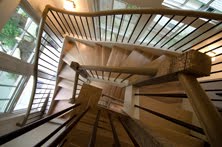Two types of radiant heat are available: 1) in-floor (most popular); and 2) wall or ceiling radiant panels.
1. In-floor radiant heat:
In-floor radiant heat is by far the most common kind of radiant systems used. There are three types of radiant floor systems: air, electric, and hot water.
Air-heated radiant floors:
Air is not a good conductor; therefore, radiant air heating systems are typically not cost effective in homes and are seldom installed. They can be combined with solar air heating systems; however they would need to be combined with a secondary heating system for non-daylight hours.

Electric radiant floors:
In this type of system, electric wires are built into the floor system or electrically conductive plastic mats are mounted to the subfloor and covered with a floor system such as tile. Electric radiant systems are only cost effective if they have a significant thermal mass such as a concrete floor. This allows you to heat the concrete floor during off-peak electric hours (overnight) and heat the home comfortably for up to 8-10 hours during high-peak electric hours (daytime). Electric radiant floor systems are practical for small additions where an additional heating system needs to be added.
Hydronic (hot water) radiant floors:
Hydronic radiant floor systems are the most popular and cost effective radiant heating system available. Water is pumped from a boiler, hot water heater, or solar collectors through tubing laid under the floor(for wood) or in a concrete or lightweight concrete slab. The tubing can be installed in zones with thermostats controlling the flow of hot water through each zone loop.

2. Radiant panels:
Radiant heat panels are usually made of aluminum and are mounted in either walls or the ceiling of a home. Heat is produced by either electric cables or plastic tubing with circulating hot water. Radiant panels can be individually controlled for each room and have a quick response time, making this heating system an option for rooms that are used infrequently. Wall panels are preferred because of the distribution of heat over the whole body as opposed to ceiling panels, which heat the head and shoulders.
If you’re building a green home, consider installing radiant heat. It creates a warm, comfortable living environment, is easy to install, and gives you a substantial return on investment!






 The open dining / living areas include built-ins for plateware, and the kitchen includes a small breakfast counter and stools. A large walk-in pantry provides additional storage space for the kitchen, and the mechanical room is housed conveniently behind the pantry pass-through door. The L in the stairs provides the perfect spot for an entry closet, while a small bench allows swimmers to towel off and remove sandals before entering the cottage.
The open dining / living areas include built-ins for plateware, and the kitchen includes a small breakfast counter and stools. A large walk-in pantry provides additional storage space for the kitchen, and the mechanical room is housed conveniently behind the pantry pass-through door. The L in the stairs provides the perfect spot for an entry closet, while a small bench allows swimmers to towel off and remove sandals before entering the cottage.















